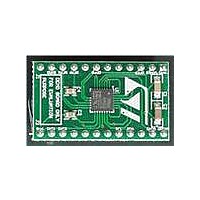STEVAL-MKI064V1 STMicroelectronics, STEVAL-MKI064V1 Datasheet - Page 17

STEVAL-MKI064V1
Manufacturer Part Number
STEVAL-MKI064V1
Description
BOARD ADAPTER LSM303DLH DIL24
Manufacturer
STMicroelectronics
Series
MEMSr
Datasheets
1.STEVAL-MKI009V1.pdf
(42 pages)
2.STEVAL-MKI063V1.pdf
(47 pages)
3.STEVAL-MKI064V1.pdf
(4 pages)
Specifications of STEVAL-MKI064V1
Sensor Type
Accelerometer and Magnetometer
Sensing Range
±2g, 4g, 8g, ±1.3 ~ 8.1 gauss
Interface
I²C
Sensitivity
1 ~ 3.9 mg/Digit, ±0.01%/°C
Embedded
No
Utilized Ic / Part
LSM303DLH
Sensing Axis
Double Axis
Output Type
Digital
Interface Type
USB
For Use With
497-10682 - MOTEHRBOARD MEMS ADAPTER STM32
Lead Free Status / RoHS Status
Lead free / RoHS Compliant
Voltage - Supply
-
Lead Free Status / Rohs Status
Lead free / RoHS Compliant
For Use With/related Products
LPR5xxxAL, LPY5xxxAL, LY5xxxAL
Other names
497-10689
LSM303DLH
4
4.1
4.2
4.3
Terminology
Linear acceleration sensitivity
Linear acceleration sensitivity describes the gain of the accelerometer sensor and can be
determined e.g. by applying 1 g acceleration to it. Because the sensor can measure DC
accelerations, this can be done easily by pointing the selected axis towards the ground,
noting the output value, rotating the sensor 180 degrees (pointing towards the sky) and
noting the output value again. By doing so, a ±1 g acceleration is applied to the sensor.
Subtracting the larger output value from the smaller one, and dividing the result by 2, leads
to the actual sensitivity of the sensor. This value changes very little over temperature and
over time. The sensitivity tolerance describes the range of sensitivities of a large number of
sensors.
Zero-g level
Zero-g level Offset (LA_TyOff) describes the deviation of an actual output signal from the
ideal output signal if no linear acceleration is present. A sensor in a steady state on a
horizontal surface will measure 0 g on both the X and Y axes, whereas the Z axis will
measure 1 g. Ideally, the output is in the middle of the dynamic range of the sensor (content
of OUT registers 00h, data expressed as 2’s complement number). A deviation from the
ideal value in this case is called Zero-g offset. Offset is to some extent a result of stress to
the MEMS sensor and therefore the offset can slightly change after mounting the sensor
onto a printed circuit board or exposing it to extensive mechanical stress. Offset changes
little over temperature; see “Linear acceleration zero-g level change vs temperature”
(LA_TCOff) in
of the range of Zero-g levels of a group of sensors.
Sleep-to-wakeup
The “sleep-to-wakeup” function, in conjunction with low-power mode, allows further
reduction of system power consumption and the development of new smart applications.
The LSM303DLH may be set to a low-power operating mode, characterized by lower date
rate refreshing. In this way the device, even if sleeping, continues sensing acceleration and
generating interrupt requests.
When the sleep-to-wakeup function is activated, the LSM303DLH is able to automatically
wake up as soon as the interrupt event has been detected, increasing the output data rate
and bandwidth. With this feature the system may be efficiently switched from low-power
mode to full-performance depending on user-selectable positioning and acceleration events,
thus ensuring power-saving and flexibility.
Table 3.
The Zero-g level tolerance (TyOff) describes the standard deviation
Doc ID 16941 Rev 1
Terminology
17/47



















